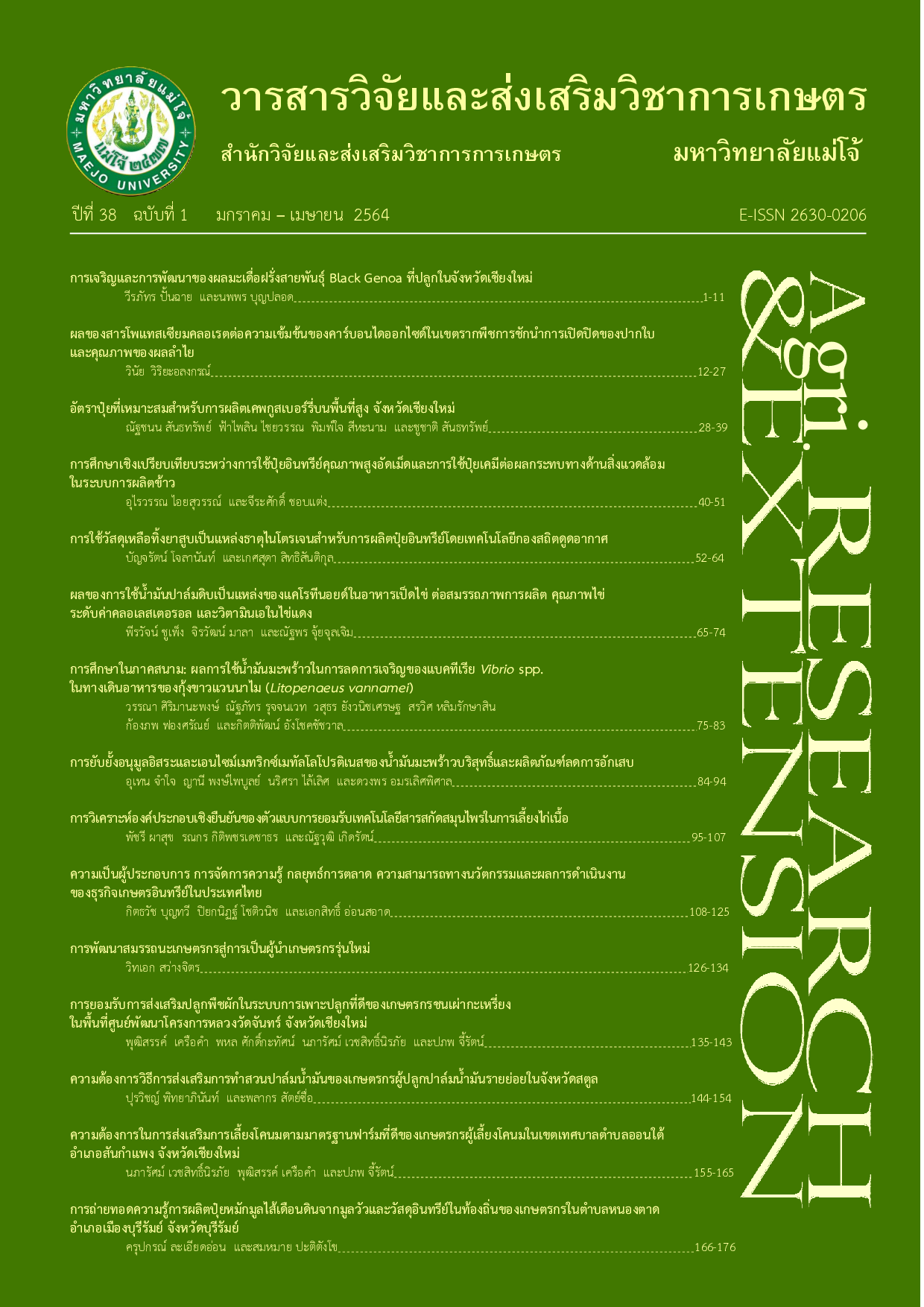ผลของการใช้น้ำมันปาล์มดิบเป็นแหล่งของแคโรทีนอยด์ในอาหารเป็ดไข่ ต่อสมรรถภาพการผลิต คุณภาพไข่ ระดับค่าคลอเลสเตอรอล และวิตามินเอในไข่แดง
คำสำคัญ:
แคโรทีนอยด์, น้ำมันปาล์มดิบ, คุณภาพไข่, เป็ดไข่บทคัดย่อ
งานวิจัยนี้มีวัตถุประสงค์เพื่อศึกษาผลของการใช้น้ำมันปาล์มดิบเป็นแหล่งของแคโรทีนอยด์ในสูตรอาหารเป็ดไข่ต่อสมรรถภาพการผลิต คุณภาพไข่ ค่าคลอเลสเตอรอล และวิตามินเอในไข่แดงของเป็ดไข่สายพันธุ์กากี แคมป์เบลล์ อายุ 27 สัปดาห์ จำนวน 180 ตัว แบ่งเป็ดทดลองออกเป็น 4 กลุ่มๆ ละ 3 ซ้ำๆ ละ 15 ตัว วางแผนการทดลองแบบสุ่มสมบูรณ์ ใช้น้ำมันปาล์มดิบที่มีแคโรทีนอยด์ความเข้มข้น 809.74 มก./กก. ในสูตรอาหารเป็ด 4 ระดับ คือ 0 (กลุ่มควบคุม) 2, 4 และ 6% ตามลำดับ ในช่วงระยะทดลอง 4 สัปดาห์ การทดลองพบว่า การใช้น้ำมันปาล์มดิบเป็นแหล่งของแคโรทีนอยด์ในสูตรอาหารไม่มีผลต่อสมรรถภาพการผลิต (ปริมาณอาหารที่กิน ผลผลิตไข่ น้ำหนักไข่) และคุณภาพไข่ (ความหนาเปลือกไข่ น้ำหนักเปลือกไข่ น้ำหนักไข่แดง น้ำหนักไข่ขาว และ ค่า Haugh unit (P>0.05) ยกเว้นสีของไข่แดง โดยกลุ่มที่ใช้น้ำมันปาล์มดิบเป็นแหล่งของแคโรทีนอยด์ในสูตรอาหารมีค่าคะแนนสีของไข่แดงเพิ่มขึ้น มีค่าเท่ากับ 5.43 (กลุ่มควบคุม) 6.60, 7.00 และ 8.26 ตามลำดับ แตกต่างจากกลุ่มควบคุมอย่างชัดเจนและเพิ่มขึ้นตามระดับเปอร์เซ็นต์น้ำมันปาล์มในสูตรอาหาร ซึ่งระดับ 6% มีคะแนนสีสูงที่สุดและค่าเฉลี่ยแตกต่างกันอย่างมีนัยสำคัญยิ่งทางสถิติ (P<0.01) ส่วนค่าคลอเลสเตอรอลและวิตามินเอในไข่แดงก็เพิ่มขึ้นไปในแนวเดียวกันและมีค่าเฉลี่ยแตกต่างกัน (P<0.01) มีค่าเท่ากับ 13.47, 13.80, 14.52 และ 19.50 มก./กรัม ตามลำดับ และ 162.00, 228.00, 326.00, และ 374.00 µgRe/100g ตามลำดับ ซึ่งจากการทดลองแสดงให้เห็นว่าการใช้น้ำมันปาล์มดิบเป็นแหล่งของแคโรทีนอยด์ในสูตรอาหารเป็ดไข่สามารถเพิ่มความเข้มสีของไข่แดง วิตามินเอและค่าคลอเลสเตอรอลโดย ไม่มีผลกระทบในเชิงลบต่อสมรรถภาพการผลิตและคุณภาพไข่
เอกสารอ้างอิง
Akarapunyavit, S., S. Isariyodom, P. Rachapaetayakom, P. Sinchaisri and W. Santisophasri. 1997. Effects of Various Fat Sources Supplemented in Laying Hen Rations. pp. 144-151. In Proceedings of the 35th Kasetsart University Annual Conference: Animal Science, Veterinary Science (Pre-forum) 3-5 Feb 1997. Bangkok: Kasetsart University. [in Thai]
Almeida, D.T., T.V. Viana, M.M. Costa, C.S. Silva and S. Feitosa. 2019. Effects of different storage conditions on the oxidative stability of crude and refined palm oil, olein and stearin (Elaeis guineensis). Food Science and Technology (Campinas) 39(Suppl.1): 211-217.
AOAC. 2016. Official Methods of Analysis of AOAC International, 20thed. Maryland: AOAC international. 3172 p.
Baharin, B.S., R.A. Latip, Y.B. Che Man and R.A. Rahman. 2001. The effect of carotene extraction system on crude palm oil quality, carotene composition, and carotene stability during storage. Journal of the American Oil Chemists’ Society 78(8): 815-855.
Fabien, D.D.F., N.N. Annie, D.M. Adélaide, S. Florian and G. Inocent. 2014. Effect of heating and of short exposure to sunlight on carotenoids content of crude palm oil. Journal of Food Processing Technology 5(4): 1-6.
Galobart, J., R. Sala, X. Rincón-Carruyo, E.G. Manzanilla, B. Vil and J. Gasa. 2004. Egg yolk color as affected by saponified oleoresin of red pepper (Capsicum annuum) fed to laying hens. Poultry Sciences 69: 462-470.
Hammond, B.R. and L.M. Renzi. 2013. Carotenoids. Advances in Nutrition 4(4): 474-476.
Kado, H., S. Wongpichet and W. Ketpanyapong. 2015. Effect of pigment from Annatto seed in layer diets on yolk color. Journal of Yala Rajabhat 10(1): 17-28. [in Thai]
Lokaewmanee K., A. Pramul and A. Kotmanee. 2016. Effect of Butea monosperma (Lam.) Taub flower powder supplementation in layer diet on egg production and egg quality. King Mongkut’s Agricultural Journal 34(3): 86-95. [in Thai]
May, C.Y. 1994. Palm oil carotenoids. Food and Nutrition Bulletin 15(2): 1-8.
National Research Council. 1994. Nutrient Requirements of Poultry 9threv. ed. Washington, D.C.: National Academy Press. 157 p.
Ng, M.H. and Y.M. Choo. 2016. Improved method for the qualitative analyses of palm oil carotenes using UPLC. Journal of Chromatographic Science 54(4): 633-638.
Office of Agricultural Economics. 2017. Important agricultural products situation and trends in 2017. [Online]. Available http://www.oae.go.th/view/1/รายละเอียดภาวะเศรษฐกิจการเกษตร/ภาวะเศรษฐกิจการเกษตร/27466/TH-TH (April 2, 2019). [in Thai]
Rattanawut, J., D. Trirabiep and N. Ketkaew. 2017. Effects of dietary water meal (Wolffia spp.) supplementation on production performance and egg yolk color of laying ducks. Khon Kaen Agriculture Journal 45(2): 249-254.
Rossi, M., M. Gianazza, C. Alamprese and F. Stanga. 2001. The Effect of Bleaching and Physical Refining on Color and Minor Components of Palm Oil. Journal of the American Oil Chemists’ Society 78(10): 1051–1055.
Tanjor, S., T. Saiwan, P. Puwastien, A. Deeaum and K. Judprasong. 2015. Nutritive value of commonly consumed eggs and effects of cooking. Kasetsart Journal Science and Technology 23(4): 651-666. [in Thai]
Ukachukwu, U., V. Ozougwu and V. Nwankwo. 2017. A comparative study on the total cholesterol, triacylglycerides and lipid concentrations of quail and chicken eggs. International Journal of Research in Pharmacy and Biosciences 4(10): 11-16.
Yap, S.C., Y.M. Choo., C.K. Ooi., A.S.H. Ong and S.H. Goh. 1991. Quantitative analysis of carotenes in the oil from different palm species Elaeis. Journal of Oil Palm Research 3(2): 369-378.
ดาวน์โหลด
เผยแพร่แล้ว
รูปแบบการอ้างอิง
ฉบับ
ประเภทบทความ
สัญญาอนุญาต
บทความนี้ได้รับการเผยแพร่ภายใต้สัญญาอนุญาต Creative Commons Attribution-NonCommercial-NoDerivatives 4.0 International (CC BY-NC-ND 4.0) ซึ่งอนุญาตให้ผู้อื่นสามารถแชร์บทความได้โดยให้เครดิตผู้เขียนและห้ามนำไปใช้เพื่อการค้าหรือดัดแปลง หากต้องการใช้งานซ้ำในลักษณะอื่น ๆ หรือการเผยแพร่ซ้ำ จำเป็นต้องได้รับอนุญาตจากวารสาร





